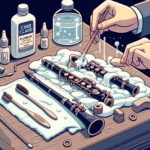Maintaining your clarinet's mouthpiece isn't just a task you do once in a while; it's a key part of taking care of your instrument. A clean mouthpiece gives you the best sound quality, keeps bacteria at bay, and helps your clarinet last longer. In this post, we'll look at different ways to clean your clarinet mouthpiece that are both quick and thorough.
Why Cleaning Your Mouthpiece Matters
The mouthpiece is where you and your instrument connect, which means it can collect residue from saliva, moisture, and other things it touches. If you don't clean it regularly, this buildup can cause:
- Changes in Sound: A dirty mouthpiece can muffle your clarinet's sound.
- Germs: Damp areas are perfect for bacteria to grow, which could make you sick.
- Unpredictable Playing: Dirt can make it hard to play consistently, leading to unexpected changes in pitch and tone.
What You Need for Cleaning
Before you start cleaning, gather these items:
- Warm Water: It helps remove gunk without damaging your mouthpiece.
- Mild Soap or Special Cleaner: Use gentle dish soap or a cleaner made for mouthpieces.
- Soft Cloth or Paper Towels: For drying and shining.
- Pipe Cleaner or Small Brush: Great for cleaning tight spots.
- Suction Bulb: Helps get water out of the mouthpiece after rinsing.
| Cleaning Frequency | Method | Benefits |
|---|---|---|
| After each use | Quick rinse with warm water | Prevents daily buildup |
| Weekly | Thorough cleaning with soap | Removes stubborn residue |
| Monthly | Deep clean with mouthpiece cleaner | Ensures optimal hygiene and performance |
How to Clean Your Mouthpiece: Step by Step
Follow these steps to clean your mouthpiece effectively:
- Get Ready: Take the mouthpiece off your clarinet to avoid damaging other parts while cleaning.
- Rinse: Run warm water over the mouthpiece to wash away loose bits. Don't use hot water as it could damage the mouthpiece.
- Soap It Up: Put a tiny drop of mild soap or mouthpiece cleaner on the mouthpiece. Use clean hands or a soft cloth to rub it gently and loosen any stuck-on grime.
- Scrub Inside: Use a pipe cleaner or small brush to clean inside the mouthpiece. Move it in circles to clean all areas, especially near the tip opening.
- Rinse Again: Wash the mouthpiece thoroughly with warm water to get rid of all the soap. This is important because leftover soap could change how your clarinet tastes and sounds.
- Dry It Off: Use a soft cloth or paper towels to dry the mouthpiece completely. Make sure it's totally dry to prevent mold or bacteria from growing.
- Use a Suction Bulb: If you have one, use a suction bulb to get any water that might be stuck inside the mouthpiece.
- Polish: Once it's dry, give the mouthpiece a final shine with a clean, dry cloth.
Keeping Your Mouthpiece in Top Shape
To keep your mouthpiece clean between deep cleanings, try these tips:
- Clean Daily: After you play, rinse the mouthpiece with warm water and let it air dry. This simple habit can prevent buildup.
- Don't Share: Like a toothbrush, it's best not to share your mouthpiece to avoid spreading germs.
- Use a Case: Keep your mouthpiece in a special case to protect it from dust and damage.
- Check Often: Look for cracks or signs of wear regularly. A worn-out mouthpiece can really affect your sound, so replace it if needed.
What Not to Do When Cleaning
Avoid these common mistakes when cleaning your clarinet mouthpiece:
- Hot Water: Remember, hot water can warp or damage the mouthpiece. Stick to warm water.
- Strong Cleaners: Harsh chemicals and rough cleaners can harm your mouthpiece's finish and material.
- Skipping Cleanings: Regular cleaning is key to keeping your mouthpiece in good shape and playing well.
By taking good care of your clarinet mouthpiece, you'll keep it in great condition for years, helping you create beautiful music every time you play. Just like how Martin Freres puts care into making their instruments, you should put care into keeping your clarinet in top shape.







